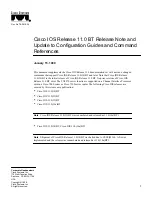
Organizing Your Inventory with Device Groups
EPICenter Concepts and Solutions Guide
71
Figure 31: Contact Information change dialog
You can change the value in the database only, or in both the database and on the device (or do neither).
You might elect to make changes in the database only if the values had already been changed on the
devices. If you are applying these changes to multiple devices, EPICenter will initiate the operation on
multiple devices concurrently.
If you are changing contact information throughout your organization, you may want to also change the
default contact information that EPICenter uses. See “Setting up Default Device Contact Information”
on page 35 for more information about this.
Organizing Your Inventory with Device Groups
Device groups in EPICenter are very useful for grouping together devices with common characteristics
so you can operate on them as a unit. Since you can put a device into multiple device groups, you can
set up special purpose groups for a variety of functions.
For example, in the previous section, putting devices into device groups based on common contact
information would simplify the process of doing bulk changes of contact information. You could just
select the entire set of devices in the group and modify the information for all those devices in a single
operation.
Another very useful function of device groups is to create groups for scoping alarms. To reduce load on
your network and on the EPICenter server, you may want to limit specific alarms to a subset of your
devices for which those events are critical. Using device groups for this purpose has several benefits.
•
First, it simplifies the alarm definition process, especially if you plan to define multiple alarms that
should all be scoped to the same subset of devices. If you don’t use a device group, you will have to
add all the devices individually to the alarm scope over again for each alarm you create.
•
Second, if you add device to the network that should be a member of this subset of devices, or if you
remove a device, you can update the device group (as a single operation) and the change will
immediately affect the scope of all alarms that use that device group. You will not need to modify
any of the alarm definitions -- the scope will be changed automatically, as the alarm is scoped to the
device group, not to individual devices.
The second point is one of the most powerful aspects of using device groups, and it applies to port
groups as well (discussed in the next section). By using groups and then taking actions on the groups
rather than on individual devices, you can simplify the overhead involved in adding or changing your
network components.
Содержание EPICenter 5.0
Страница 12: ...12 EPICenter Concepts and Solutions Guide Preface...
Страница 76: ...76 EPICenter Concepts and Solutions Guide Managing your Network Assets...
Страница 92: ...92 EPICenter Concepts and Solutions Guide Managing VLANs...
Страница 116: ...116 EPICenter Concepts and Solutions Guide Managing Wireless Networks...
Страница 146: ...146 EPICenter Concepts and Solutions Guide VoIP and EPICenter Avaya Integrated Management...
Страница 163: ...Appendices...
Страница 164: ......
Страница 178: ...178 EPICenter Concepts and Solutions Guide Troubleshooting...
















































